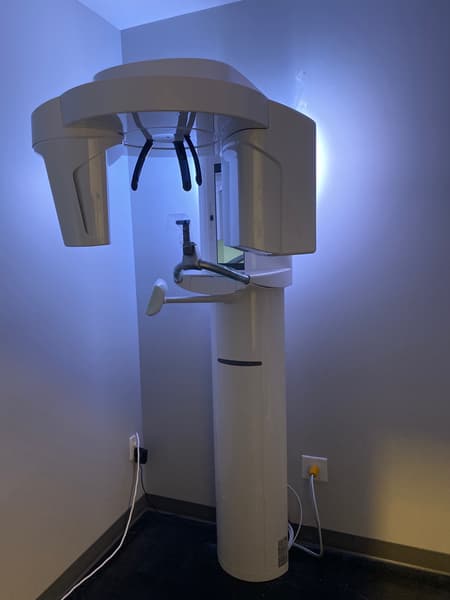
Cone Beam CT in Longmont
Are you looking for a Cone Beam CT? If so, we can help. We’re one of the few dental offices in Longmont that has this amazing piece of technology. Not only does it help us improve treatment planning, but it also helps make the dental experience more convenient for you.
What Is a Cone Beam CT?
CBCT stands for cone-beam computer tomography, deriving its name from the cone shape of its X-ray beam.
Because CBCT machines are a significant investment, most dental offices don’t have this technology. Our office has owned and used one since 2019, enabling us to provide even better dental care for our patients.
Unlike traditional 2D X-rays, CBCT images are in 3D. They also produce hundreds of images during a single rotation, which provides Dr. Hedrick and Dr. Ryan with more information than they would get from a traditional X-ray. And the more information we have, the better.
CBCTs share similarities with traditional CTs that you would find in a hospital, but CBCTs were developed specifically for dentists and oral surgeons, making them better suited for oral care.
What Is the Process for a CBCT?
It’s an uncomplicated process where you can either sit or stand for the scans, but it’s important that you remain still. It only takes about ten seconds to complete a full-mouth scan where hundreds of images are taken. Afterward, the computer will reconstruct these images so the dentist can view them easily.
What Does a CBCT Show?
The high-quality 3D images show the teeth, bone, gums, and nerves, making it more comprehensive and clearer than a traditional X-ray.
They also show cross-sections of the head and neck, and multiple X-rays can be spliced together to enable an interactive viewing experience and ensure the accuracy of treatment planning.
CBCT vs. Traditional X-Ray
A CBCT is three-dimensional and can take many more pictures from a scan than a traditional X-ray can. It also provides an interactive experience where the dentist can view cross-sections of your mouth, ensuring better treatment planning.
CBCT vs. Traditional CT
As mentioned, CBCTs were designed for dentists and are better suited toward oral health than a traditional CT. The images are just as accurate but emit less radiation,¹ and scanning can take place entirely at the dentist’s office.
Uses for the CBCT in Dentistry
- Access airways for sleep studies
- Implant placement
- Infections
- Periodontal tissues
- Sinuses
- Teeth that aren’t visible on a regular X-ray
- Temporomandibular joints (TMJ)
How Does a CBCT Help With Placing Dental Implants?
It helps by allowing us to perfect implant placement, such as informing us to avoid areas with low bone density as well as structures like nerves, sinuses, and tooth roots.
How to Prepare for a CBCT Scan
Luckily, these scans don’t require much preparation other than removing any metal, jewelry and eyeglasses beforehand. Please also let us know if you’re pregnant before going ahead with the scan.
CBCT Appointments for Other Clinicians in Longmont
If you’re a healthcare provider in Longmont who needs to refer a patient for a CBCT scan, we would be happy to help. Please contact our office at 303-772-6333 and we can provide more information.
Do I Need to Be an Existing Patient for a CBCT?
We realize that most dental offices don’t have this technology, so it’s not necessary to be an existing patient of ours for this scan. Please call our office at 303-772-6333 for more information.
References
- Dental Economics (2011, January 1). Cone Beam Computed Tomography: How safe is CBCT for your patients? Dentaleconomics.com. Retrieved November 7, 2023 from https://www.dentaleconomics.com/science-tech/article/16394714/cone-beam-computed-tomography-how-safe-is-cbct-for-your-patients.